Wrought Steel vs Cast Steel
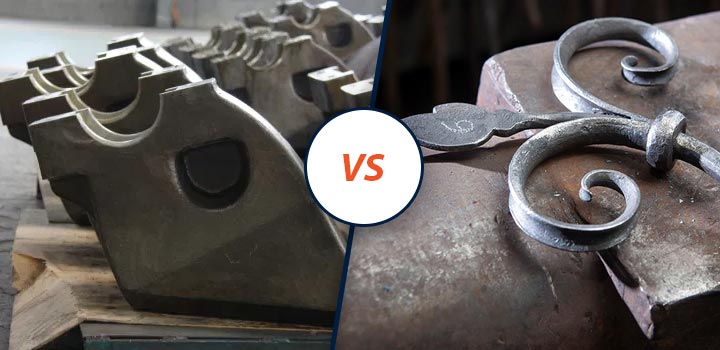
Wrought steel and cast steel are often confused by consumers and manufacturers due to their similar names. However, they are two distinct types of metal with unique properties and applications. Understanding the differences between them can help in selecting the right material for specific industrial or construction needs.
Wrought steel is typically produced by heating the metal and then shaping it using tools and machinery. This process enhances its strength and flexibility. On the other hand, cast steel involves melting the metal, pouring it into a mold, and allowing it to solidify. The term "wrought" refers to the working of the metal, while "cast" relates to the casting process used during manufacturing.
Wrought steel is known for its high ductility and ability to be reheated and reshaped multiple times. It has lower carbon content compared to cast iron, which makes it more malleable and easier to work with. Its advantages include:
- Excellent welding properties, making it ideal for custom shaping.
- High flexibility and ductility, suitable for applications requiring movement or bending.
- Strong tensile strength, offering durability in harsh environments.
- Easy to forge, allowing for the creation of complex shapes.
Cast steel, on the other hand, contains 2.0–4.0% carbon, along with varying amounts of manganese and silicon. It is created by melting iron ore and blending it with other metals and alloys. The molten mixture is then poured into a mold and allowed to cool. Compared to wrought steel, cast steel is harder and more brittle, but it offers greater compressive strength and wear resistance.
It is commonly used in the production of cookware, mechanical components, and construction materials. Some of its key benefits include:
- High compression strength, providing excellent resistance to pressure.
- Good durability, which can be further enhanced through alloying and heat treatment.
- Excellent machinability, allowing for easy cutting, drilling, and grinding.
- High wear resistance, especially when elements like chromium or molybdenum are added.
Table of Contents
- Difference between Wrought Steel and Cast Steel
- Heat Treatment of Cast Steel
- Advantages and Disadvantages of Cast Iron
- Advantages of Wrought Iron
- Puddling Process vs Metal Casting Process
- Types of Cast Iron
- Properties of 4140 Cast Steel
- Chemical Composition of Cast Iron
- Cast Iron Mechanical Properties
- AISI 4140 Heat Treatment
- Wrought Iron Chemical Composition
- Wrought Steel Mechanical Properties
- Inspection and Testing of Cast Steel
- Manufacturing Process of 4340 Steel Casting
- Cast Steel Valves Temperature Range
- Difference Between Wrought Iron and Steel
- Surface Finish of Cast Iron Parts
Difference Between Wrought Steel and Cast Steel
| Wrought Iron | Cast Iron |
|---|---|
| Heated and worked with tools | Melted, poured into molds, and solidified |
| Brittle | Ductile |
| Higher tensile strength | Lower tensile strength compared to wrought iron |
| Low melting point | High melting point |
| Difficult to weld | Easier to weld |
Proper Technique for Welding Cast Steel: Check 4140/4340 Steel Heat Treatment and Casting Hardness
Heat Treatment of Cast Steel
- Annealing
- Precipitation Strengthening
- Tempering
- Case Hardening
- Normalising
- Quenching
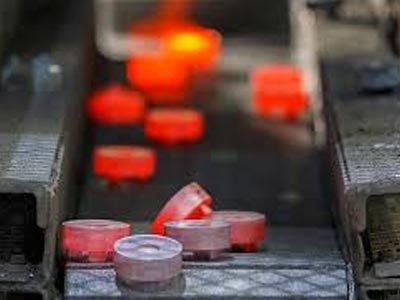
Explore the Benefits of Cast and Wrought Steel Products
Advantages and Disadvantages of Cast Iron Steel
Advantages
- Excellent fluidity after melting
- High wear resistance
- Good machinability
- High compression strength
- Low cost
Disadvantages
- Brittle and prone to cracking
- Prone to rusting
- Heavy in weight
Advantages of Wrought Iron
- Increased ductility
- Excellent weldability
- Easily forged
- High tensile and compressive strength
- Enhanced malleability
Understand the Difference Between Puddling and Metal Casting
Puddling Process vs Metal Casting Process
The puddling process involves converting pig iron into wrought iron by heating and stirring it in a furnace without using charcoal. This was an early method that enabled the mass production of wrought iron. In contrast, metal casting involves melting metal and pouring it into a mold to create the desired shape. It is widely used for producing complex parts that would be difficult or costly to make otherwise.
Types of Cast Iron
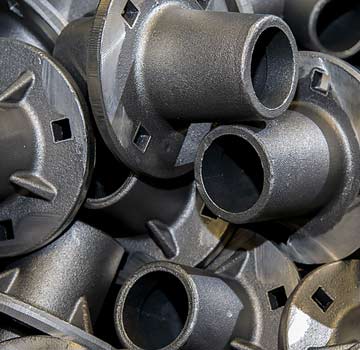
Gray Cast Iron
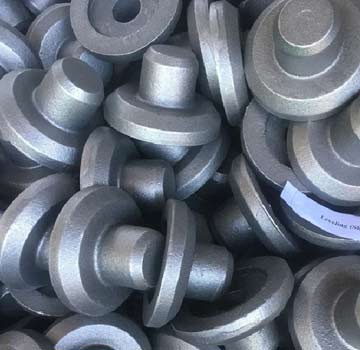
Ductile Cast Iron
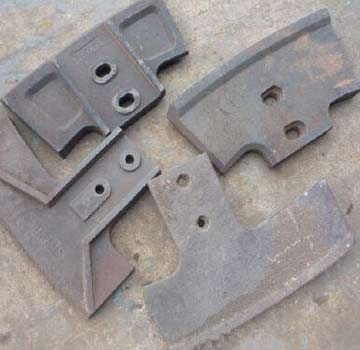
White Cast Iron
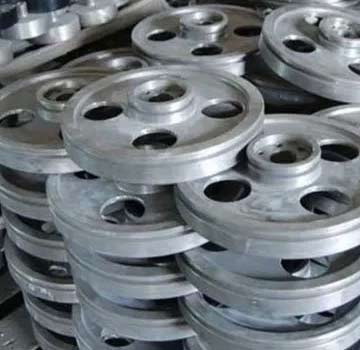
Malleable Cast Iron
Properties of 4140 Cast Steel
- Hardness
- Ductility
- Wear Resistance
- Corrosion Resistance
- Toughness
- Strength
- Machinability
- Weldability
- Low-Temperature Properties
- High-Temperature Properties
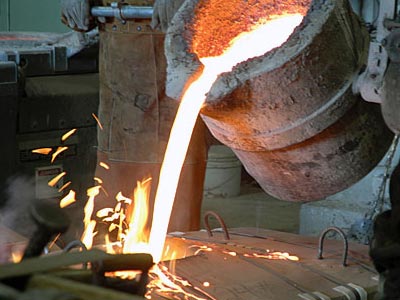
Explore Different Types of Cast Steel Materials, Grades, Composition, and Density in kg/m³
Chemical Composition of Cast Iron
| ASTM | Chemical Requirements | ||||
|---|---|---|---|---|---|
| STEEL GRADE | Carbon | Manganese | Silicon | Sulfur | Phosphorus |
| Max % / Range | |||||
| ASTM A27 / A27M | |||||
| Grade N-1 | 0.25 | 0.75 | 0.80 | 0.06 | 0.05 |
| Grade N-2 | 0.35 | 0.60 | 0.80 | 0.06 | 0.05 |
| Grade U60-30 | 0.25 | 0.75 | 0.80 | 0.06 | 0.05 |
| Grade 60-30 | 0.30 | 0.60 | 0.80 | 0.06 | 0.05 |
| Grade 65-35 | 0.30 | 0.70 | 0.80 | 0.06 | 0.05 |
| Grade 70-36 | 0.35 | 0.70 | 0.80 | 0.06 | 0.05 |
| Grade 70-40 | 0.25 | 1.20 | 0.80 | 0.06 | 0.05 |
| ASTM A148 / A148M | |||||
| Grade 80-40 | N/A | N/A | N/A | 0.06 | 0.05 |
| Grade 80-50 | N/A | N/A | N/A | 0.06 | 0.05 |
| Grade 90-60 | N/A | N/A | N/A | 0.06 | 0.05 |
| ASTM A216 / A216M | |||||
| Grade WCA | 0.25 | 0.70 | 0.60 | 0.045 | 0.04 |
| Grade WCB | 0.30 | 1.00 | 0.60 | 0.045 | 0.04 |
| Grade WCC | 0.25 | 1.20 | 0.60 | 0.045 | 0.04 |
Cast Iron Mechanical Properties
| ASTM | Mechanical Properties | |||
|---|---|---|---|---|
| STEEL GRADE | Tensile Strength | Yield Point | Elongation in 2 in. | Reduction of Area |
| Min. ksi [Mpa] / Range | Min. % | |||
| ASTM A27 / A27M | ||||
| Grade U60-30 | 60 [415] | 30 [205] | 22 | 30 |
| Grade 60-30 | 60 [415] | 30 [205] | 24 | 35 |
| Grade 65-35 | 65 [450] | 35 [240] | 24 | 35 |
| Grade 70-36 | 70 [485] | 36 [250] | 22 | 30 |
| Grade 70-40 | 70 [485] | 40 [275] | 22 | 30 |
| ASTM A148 / A148M | ||||
| Grade 80-40 | 80 [550] | 40 [275] | 18 | 30 |
| Grade 80-50 | 80 [550] | 50 [345] | 22 | 35 |
| Grade 90-60 | 90 [620] | 60 [415] | 20 | 40 |
| ASTM A216 / A216M | ||||
| Grade WCA | 60-85 [415-585] | 30 [205] | 24 | 35 |
| Grade WCB | 70-95 [485-655] | 36 [250] | 22 | 35 |
| Grade WCC | 70-95 [485-655] | 40 [275] | 22 | 35 |
AISI 4140 Heat Treatment
| Soft annealing °C | Cooling | Hardness HB |
|---|---|---|
| 650-700 | slowly | max. 280 |
| Stress-relief annealing °C | Cooling |
|---|---|
| 630 – 650 | Furnace |
| 1st pre-heating °C | 2nd and 3rd | Hardening °C | Quenching | Tempering °C | Hardness after Tempering HRC |
|---|---|---|---|---|---|
| up to approx. 400 in an air-circulating furnace | 780 and 1000 | 1190 – 1230 | Saltbath, at least 520 °C Oil ,Air | at least twice 530-560 | 64 – 66 |
Wrought Iron Chemical Composition
| Element | Iron, Fe | Carbon, C | Phosphorus, P | Silicon, Si | Sulfur, S | Manganese, Mn |
|---|---|---|---|---|---|---|
| Content (%) | 99-99.8 | 0.05-0.25 | 0.05-0.2 | 0.02-0.2 | 0.02-0.1 | 0.01-0.1 |
Wrought Steel Mechanical Properties
| Properties | Imperial | Metric |
|---|---|---|
| Tensile strength | 34000-54000 psi | 234-372 MPa |
| Modulus of elasticity | 28000 ksi | 193100 MPa |
| Yield strength | 23000-32000 psi | 159-221 MPa |
Inspection and Testing of Cast Steel
- Dimensional accuracy
- Surface finish condition
- Internal soundness
- Chemical analysis
- Heat analysis
- Tensile properties
- Impact properties
- Hardness
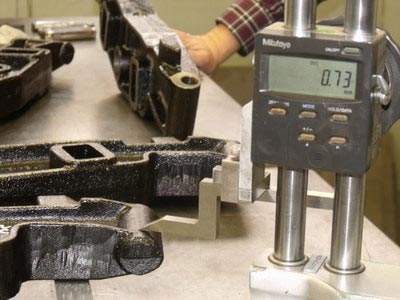
Manufacturing Process of 4340 Steel Casting
- Furnace charging
- Melting
- Refining
- De-slagging
- Tapping (or tap out)
- Furnace turn-around
Check Cast Steel Valves Uses and Temperature Limit
Cast Steel Valves Temperature Range
| Temperature range | -29°C to 425°C |
|---|
Difference Between Wrought Iron and Steel
| Characteristics | Wrought Iron | Steel |
|---|---|---|
| Carbon Content | 0.08% | 4% |
| Tensile Strength | Very good tensile strength | Greater tensile strength |
| Workmanship | Requires less workmanship. | Requires more craftsmanship than wrought iron |
Surface Finish of Cast Iron Parts
- Shot Blasting
- Painting
- Powder Coating
- Electroplating
Oil And Gas Processing Heat Transfer Fluid
Heat Transfer Fluids,Oil Processing Transfer Fluid,Gas Processing Transfer Fluid,Oil Processing Heat Transfer Fluid
Heat Transfer Fluids , https://www.armcoltherm.com
